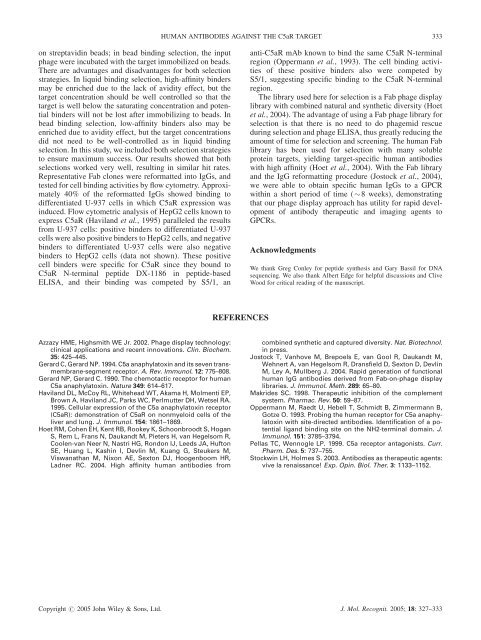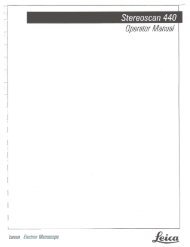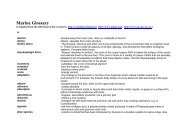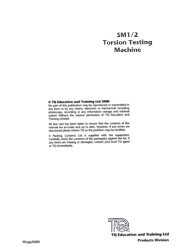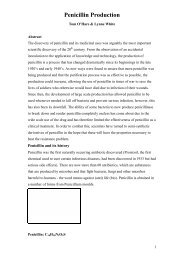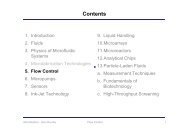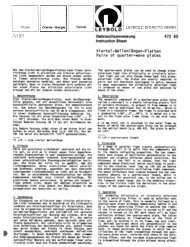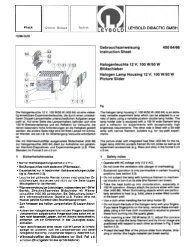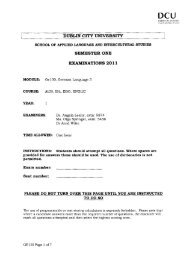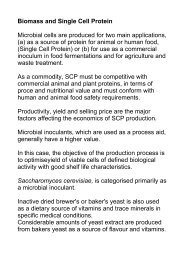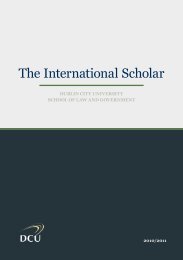Discovery of human antibodies against the C5aR target using ... - DCU
Discovery of human antibodies against the C5aR target using ... - DCU
Discovery of human antibodies against the C5aR target using ... - DCU
Create successful ePaper yourself
Turn your PDF publications into a flip-book with our unique Google optimized e-Paper software.
HUMAN ANTIBODIES AGAINST THE <strong>C5aR</strong> TARGET 333<br />
on streptavidin beads; in bead binding selection, <strong>the</strong> input<br />
phage were incubated with <strong>the</strong> <strong>target</strong> immobilized on beads.<br />
There are advantages and disadvantages for both selection<br />
strategies. In liquid binding selection, high-affinity binders<br />
may be enriched due to <strong>the</strong> lack <strong>of</strong> avidity effect, but <strong>the</strong><br />
<strong>target</strong> concentration should be well controlled so that <strong>the</strong><br />
<strong>target</strong> is well below <strong>the</strong> saturating concentration and potential<br />
binders will not be lost after immobilizing to beads. In<br />
bead binding selection, low-affinity binders also may be<br />
enriched due to avidity effect, but <strong>the</strong> <strong>target</strong> concentrations<br />
did not need to be well-controlled as in liquid binding<br />
selection. In this study, we included both selection strategies<br />
to ensure maximum success. Our results showed that both<br />
selections worked very well, resulting in similar hit rates.<br />
Representative Fab clones were reformatted into IgGs, and<br />
tested for cell binding activities by flow cytometry. Approximately<br />
40% <strong>of</strong> <strong>the</strong> reformatted IgGs showed binding to<br />
differentiated U-937 cells in which <strong>C5aR</strong> expression was<br />
induced. Flow cytometric analysis <strong>of</strong> HepG2 cells known to<br />
express <strong>C5aR</strong> (Haviland et al., 1995) paralleled <strong>the</strong> results<br />
from U-937 cells: positive binders to differentiated U-937<br />
cells were also positive binders to HepG2 cells, and negative<br />
binders to differentiated U-937 cells were also negative<br />
binders to HepG2 cells (data not shown). These positive<br />
cell binders were specific for <strong>C5aR</strong> since <strong>the</strong>y bound to<br />
<strong>C5aR</strong> N-terminal peptide DX-1186 in peptide-based<br />
ELISA, and <strong>the</strong>ir binding was competed by S5/1, an<br />
anti-<strong>C5aR</strong> mAb known to bind <strong>the</strong> same <strong>C5aR</strong> N-terminal<br />
region (Oppermann et al., 1993). The cell binding activities<br />
<strong>of</strong> <strong>the</strong>se positive binders also were competed by<br />
S5/1, suggesting specific binding to <strong>the</strong> <strong>C5aR</strong> N-terminal<br />
region.<br />
The library used here for selection is a Fab phage display<br />
library with combined natural and syn<strong>the</strong>tic diversity (Hoet<br />
et al., 2004). The advantage <strong>of</strong> <strong>using</strong> a Fab phage library for<br />
selection is that <strong>the</strong>re is no need to do phagemid rescue<br />
during selection and phage ELISA, thus greatly reducing <strong>the</strong><br />
amount <strong>of</strong> time for selection and screening. The <strong>human</strong> Fab<br />
library has been used for selection with many soluble<br />
protein <strong>target</strong>s, yielding <strong>target</strong>-specific <strong>human</strong> <strong>antibodies</strong><br />
with high affinity (Hoet et al., 2004). With <strong>the</strong> Fab library<br />
and <strong>the</strong> IgG reformatting procedure (Jostock et al., 2004),<br />
we were able to obtain specific <strong>human</strong> IgGs to a GPCR<br />
within a short period <strong>of</strong> time (8 weeks), demonstrating<br />
that our phage display approach has utility for rapid development<br />
<strong>of</strong> antibody <strong>the</strong>rapeutic and imaging agents to<br />
GPCRs.<br />
Acknowledgments<br />
We thank Greg Conley for peptide syn<strong>the</strong>sis and Gary Bassil for DNA<br />
sequencing. We also thank Albert Edge for helpful discussions and Clive<br />
Wood for critical reading <strong>of</strong> <strong>the</strong> manuscript.<br />
REFERENCES<br />
Azzazy HME, Highsmith WE Jr. 2002. Phage display technology:<br />
clinical applications and recent innovations. Clin. Biochem.<br />
35: 425–445.<br />
Gerard C, Gerard NP. 1994. C5a anaphylatoxin and its seven transmembrane-segment<br />
receptor. A. Rev. Immunol. 12: 775–808.<br />
Gerard NP, Gerard C. 1990. The chemotactic receptor for <strong>human</strong><br />
C5a anaphylatoxin. Nature 349: 614–617.<br />
Haviland DL, McCoy RL, Whitehead WT, Akama H, Molmenti EP,<br />
Brown A, Haviland JC, Parks WC, Perlmutter DH, Wetsel RA.<br />
1995. Cellular expression <strong>of</strong> <strong>the</strong> C5a anaphylatoxin receptor<br />
(<strong>C5aR</strong>): demonstration <strong>of</strong> <strong>C5aR</strong> on nonmyeloid cells <strong>of</strong> <strong>the</strong><br />
liver and lung. J. Immunol. 154: 1861–1869.<br />
Hoet RM, Cohen EH, Kent RB, Rookey K, Schoonbroodt S, Hogan<br />
S, Rem L, Frans N, Daukandt M, Pieters H, van Hegelsom R,<br />
Coolen-van Neer N, Nastri HG, Rondon IJ, Leeds JA, Hufton<br />
SE, Huang L, Kashin I, Devlin M, Kuang G, Steukers M,<br />
Viswanathan M, Nixon AE, Sexton DJ, Hoogenboom HR,<br />
Ladner RC. 2004. High affinity <strong>human</strong> <strong>antibodies</strong> from<br />
combined syn<strong>the</strong>tic and captured diversity. Nat. Biotechnol.<br />
in press.<br />
Jostock T, Vanhove M, Brepoels E, van Gool R, Daukandt M,<br />
Wehnert A, van Hegelsom R, Dransfield D, Sexton D, Devlin<br />
M, Ley A, Mullberg J. 2004. Rapid generation <strong>of</strong> functional<br />
<strong>human</strong> IgG <strong>antibodies</strong> derived from Fab-on-phage display<br />
libraries. J. Immunol. Meth. 289: 65–80.<br />
Makrides SC. 1998. Therapeutic inhibition <strong>of</strong> <strong>the</strong> complement<br />
system. Pharmac. Rev. 50: 59–87.<br />
Oppermann M, Raedt U, Hebell T, Schmidt B, Zimmermann B,<br />
Gotze O. 1993. Probing <strong>the</strong> <strong>human</strong> receptor for C5a anaphylatoxin<br />
with site-directed <strong>antibodies</strong>. Identification <strong>of</strong> a potential<br />
ligand binding site on <strong>the</strong> NH2-terminal domain. J.<br />
Immunol. 151: 3785–3794.<br />
Pellas TC, Wennogle LP. 1999. C5a receptor antagonists. Curr.<br />
Pharm. Des. 5: 737–755.<br />
Stockwin LH, Holmes S. 2003. Antibodies as <strong>the</strong>rapeutic agents:<br />
vive la renaissance! Exp. Opin. Biol. Ther. 3: 1133–1152.<br />
Copyright # 2005 John Wiley & Sons, Ltd. J. Mol. Recognit. 2005; 18: 327–333


